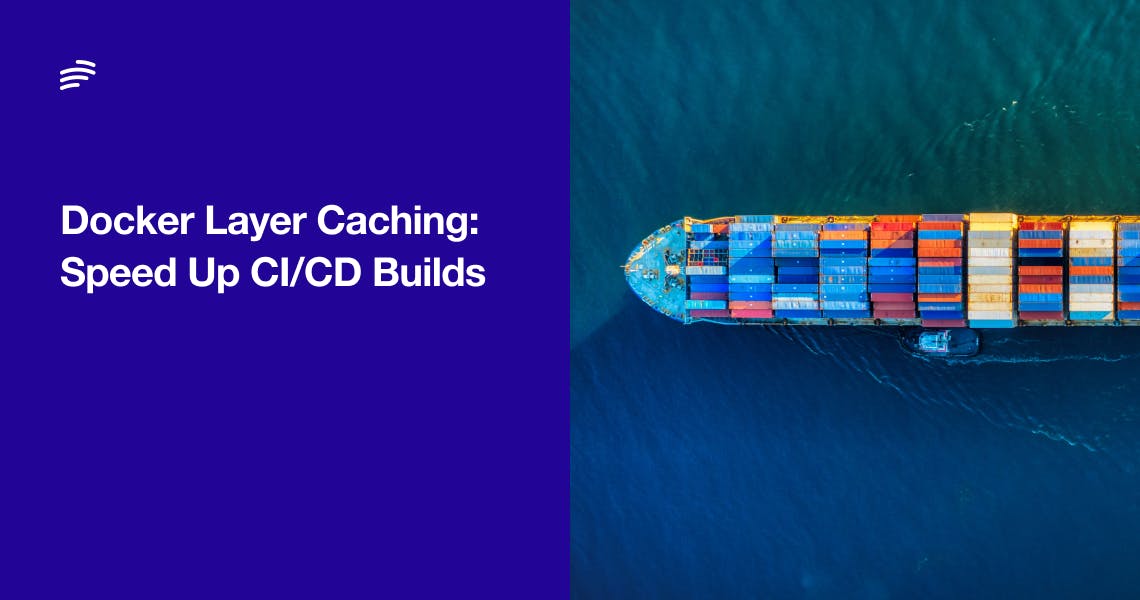Docker layer caching (DLC) is a powerful technique that can significantly accelerate your CI/CD pipelines. By reusing unchanged image layers across builds, DLC not only cuts down on build times but also reduces cloud costs and boosts developer productivity. In this article, we’ll break down how Docker layer caching works, how to implement it effectively, and how to combine it with ephemeral environments for maximum impact.
🚀 Why Docker Layer Caching Matters
CI/CD pipelines often become bottlenecks due to long build times, especially in complex microservice architectures. Docker layer caching addresses this by reusing layers from previous builds if they remain unchanged — eliminating the need to rebuild everything from scratch.
Key benefits:
- Faster builds (up to 40%+ speed improvements)
- Lower cloud costs (reduced compute usage)
- Improved developer velocity (less waiting)
- Higher environment consistency
🧠 How Docker Layer Caching Works
When you run docker build, each instruction in your Dockerfile (e.g. RUN, COPY, ADD) creates a new layer. Docker checks whether these instructions and the corresponding files have changed:
If unchanged, it reuses the cached layer.
If changed, it rebuilds that layer and all layers that follow.
🔁 This means Dockerfile structure matters — more on that below.
Example:
FROM node:18-alpine
WORKDIR /app
# Stable dependencies first
COPY package*.json ./
RUN npm ci --only=production
# Frequently changing app code last
COPY . .
CMD ["npm", "start"]
If your application code changes but dependencies don’t, Docker will only rebuild the final steps, saving time and resources.
🧰 Optimizing Dockerfiles for Caching
To get the most from caching, structure your Dockerfile strategically:
| Optimization Strategy | Benefit |
|---|---|
| Place stable instructions first | Preserves earlier cache layers |
| Use multi-stage builds | Isolates build from runtime steps |
| Copy only what’s needed | Reduces cache invalidation |
| Alphabetize multi-line arguments | Simplifies diffs and improves reuse |
Use .dockerignore | Prevents unnecessary file changes from triggering rebuilds |
⚙️ Setting Up Caching in CI/CD
✅ GitHub Actions
- name: Build with cache
uses: docker/build-push-action@v6
with:
context: .
push: true
tags: myapp:latest
cache-from: type=gha
cache-to: type=gha,mode=max
Use type=gha for GitHub-hosted caching and mode=max for maximum reuse.
✅ GitLab CI/CD
build:
stage: build
script:
- docker pull $CI_REGISTRY_IMAGE:latest || true
- docker build --build-arg BUILDKIT_INLINE_CACHE=1 \
--cache-from $CI_REGISTRY_IMAGE:latest \
--tag $CI_REGISTRY_IMAGE:$CI_COMMIT_SHA \
--tag $CI_REGISTRY_IMAGE:latest .
- docker push $CI_REGISTRY_IMAGE:$CI_COMMIT_SHA
- docker push $CI_REGISTRY_IMAGE:latest
GitLab also supports advanced caching with Docker BuildKit and Buildx.
🧪 Advanced Caching with Docker BuildKit
With BuildKit (default since Docker v23), you can:
- Export/import cache across environments
- Run parallel builds
- Skip unused stages
- Enable granular control over caching behavior
GitLab BuildKit Example:
build:
stage: build
script:
- docker buildx create --use
- docker buildx build --push \
--cache-from type=registry,ref=$CI_REGISTRY_IMAGE/cache \
--cache-to type=registry,ref=$CI_REGISTRY_IMAGE/cache,mode=max \
-t $CI_REGISTRY_IMAGE:$CI_COMMIT_SHA .
Available Cache Backends:
| Backend | Use Case | Configuration Example |
|---|---|---|
type=registry | Shared across branches | ref=myregistry.com/cache-image |
type=gha | GitHub-hosted runners | GitHub Actions only |
type=local | Local builds | dest=/tmp/cache |
type=s3 | Cloud cache storage | bucket=my-cache-bucket |
🧹 Managing Your Docker Cache
To keep performance high and avoid bloated caches:
- Use docker system df and docker builder prune
- Automate cleanup with retention policies
- Monitor cache hit rates and build durations
- Use descriptive keys for cache (e.g. by commit SHA or branch)
🌱 Using Ephemeral Environments with Caching
Ephemeral environments — like those provided by Bunnyshell — spin up fresh, production-like environments for each branch or pull request.
Combined with Docker layer caching, this gives you:
- Clean builds without cache pollution
- Consistent environments across PRs
- Reduced costs (no idle VMs)
- Faster feedback loops for testing
Bunnyshell integrates seamlessly with Docker and BuildKit, automatically reusing base layers while spinning up isolated test environments for each pipeline run.
📈 Measuring Results: Speed & Cost
⏱️ Build Time Impact
Use time docker build or docker buildx build to compare builds with and without cache. Track:
- Total duration
- Per-layer timing
- Cache hit rates
Run multiple times to average out results.
💰 Cost Savings
If your compute costs $0.10/min, and you save 5 minutes per build across 1,000 builds/month:
→ $500/month saved
Multiply by build frequency and developer count to see the full impact.
✅ Key Takeaways
- Structure your Dockerfile for maximum cache reuse
- Use BuildKit and Buildx to unlock advanced caching
- Integrate caching into GitHub Actions, GitLab, or other CI/CD tools
- Pair with ephemeral environments (like Bunnyshell) for isolated, efficient builds
- Track results and clean up unused cache regularly
🧭 What’s Next?
- Enable Docker Layer Caching in your CI tool.
- Refactor your Dockerfiles for cache efficiency.
- Use BuildKit and multi-stage builds to separate concerns.
- Monitor results and clean old cache routinely.
- Try ephemeral environments to maximize both speed and consistency.
Need a hand?
Get a demo of Bunnyshell to see how caching + ephemeral environments can boost your dev team’s productivity by 10x.
📌 FAQs
Q: What’s the best way to structure a Dockerfile for caching?
A: Place stable commands (e.g. installing packages) at the top and frequently changed ones (e.g. copying source code) at the end.
Q: Why is Docker BuildKit better than the old system?
A: BuildKit supports layer reuse across environments, parallel builds, and external caching – all of which make CI/CD pipelines faster and cheaper.
Q: How do ephemeral environments help with Docker caching?
A: They ensure clean, isolated build environments that retain valid Docker cache layers while preventing pollution or drift.
